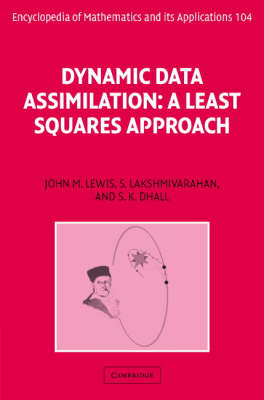
Dynamic Data Assimilation
Cambridge University Press (Verlag)
978-0-521-85155-8 (ISBN)
Dynamic data assimilation is the assessment, combination and synthesis of observational data, scientific laws and mathematical models to determine the state of a complex physical system, for instance as a preliminary step in making predictions about the system's behaviour. The topic has assumed increasing importance in fields such as numerical weather prediction where conscientious efforts are being made to extend the term of reliable weather forecasts beyond the few days that are presently feasible. This book is designed to be a basic one-stop reference for graduate students and researchers. It is based on graduate courses taught over a decade to mathematicians, scientists, and engineers, and its modular structure accommodates the various audience requirements. Thus Part I is a broad introduction to the history, development and philosophy of data assimilation, illustrated by examples; Part II considers the classical, static approaches, both linear and nonlinear; and Part III describes computational techniques. Parts IV to VII are concerned with how statistical and dynamic ideas can be incorporated into the classical framework. Key themes covered here include estimation theory, stochastic and dynamic models, and sequential filtering. The final part addresses the predictability of dynamical systems. Chapters end with a section that provides pointers to the literature, and a set of exercises with instructive hints.
John M. Lewis is a Research Scientist at the National Severe Storms Laboratory in Oklahoma, and the Desert Research Institute in Nevada. S. Lakshmivarahan is a George Lynn Cross Research Professor at the School of Computer Science, University of Oklahoma. Sudarshan K. Dhall is a Professor at the School of Computer Science, University of Oklahoma.
1. Synopsis; 2. Pathways into data assimilation: illustrative examples; 3. Applications; 4. Brief history of data assimilation; 5. Linear least squares estimation: method of normal equations; 6. A geometric view: projection and invariance; 7. Nonlinear least squares estimation; 8. Recursive least squares estimation; 9. Matrix methods; 10. Optimisation: steepest descent method; 11. Conjugate direction/gradient methods; 12. Newton and quasi-Newton methods; 13. Principles of statistical estimation; 14. Statistical least squares estimation; 15. Maximum likelihood method; 16. Bayesian estimation method; 17. From Gauss to Kalman: sequential, linear minimum variance estimation; 18. Data assimilation-static models: concepts and formulation; 19. Classical algorithms for data assimilation; 20. 3DVAR - a Bayesian formulation; 21. Spatial digital filters; 22. Dynamical data assimilation: the straight line problem; 23. First-order adjoint method: linear dynamics; 24. First-order adjoint method: nonlinear dynamics; 25. Second-order adjoint method; 26. The ADVAR problem: a statistical and a recursive view; 27. Linear filtering - Part I: Kalman filter; 28. Linear filtering-part II; 29. Nonlinear filtering; 30. Reduced rank filters; 31. Predictability: a stochastic view; 32. Predictability: a deterministic view; Bibliography; Index.
| Erscheint lt. Verlag | 3.8.2006 |
|---|---|
| Reihe/Serie | Encyclopedia of Mathematics and its Applications |
| Zusatzinfo | Worked examples or Exercises; 29 Tables, unspecified |
| Verlagsort | Cambridge |
| Sprache | englisch |
| Maße | 164 x 244 mm |
| Gewicht | 1100 g |
| Themenwelt | Mathematik / Informatik ► Mathematik ► Angewandte Mathematik |
| Naturwissenschaften ► Geowissenschaften ► Meteorologie / Klimatologie | |
| ISBN-10 | 0-521-85155-6 / 0521851556 |
| ISBN-13 | 978-0-521-85155-8 / 9780521851558 |
| Zustand | Neuware |
| Informationen gemäß Produktsicherheitsverordnung (GPSR) | |
| Haben Sie eine Frage zum Produkt? |
aus dem Bereich


